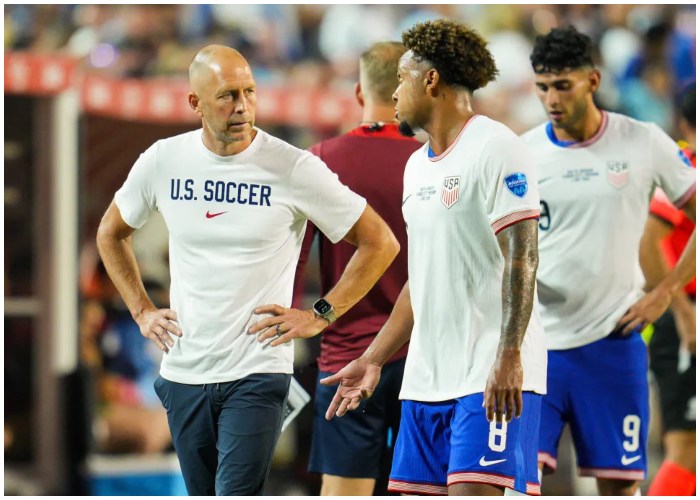The U.S. men’s national team suffered a 1-0 defeat to Uruguay in their final first-round match, marking their second consecutive loss after an initial win over Bolivia. That victory, achieved eight days ago in Dallas, now feels distant.
The Americans’ early exit from the oldest international soccer competition is a harsh reality check, especially considering it was seen as a preparation for the 2026 FIFA World Cup, which will be co-hosted by the U.S., Mexico, and Canada.
Performance Concerns and Coaching Uncertainty
The home team’s performance over the three games highlighted significant issues within a squad touted as the deepest and most talented in American soccer history. Scoring only three goals in three games is far from satisfactory for a team aiming to demonstrate its capability to win knockout games against top-tier opponents. This poor performance may cost coach Berhalter his job. Despite a strong effort following their loss to Panama, the U.S. never seemed likely to score or win against Uruguay, a game they needed to advance to the quarterfinals. The lackluster performance has sparked discussions about the future of the coaching staff and the overall direction of the team. Fans and analysts alike are questioning the tactical decisions made during the tournament, including player selections and formations. The inability to convert scoring opportunities into goals has been a glaring weakness, highlighting the need for a more effective offensive strategy.

Missed Opportunities and Key Moments
The Americans’ best chance to score came in the first half when Gio Reyna broke through Uruguay’s defense and attempted to set up Folarin Balogun. However, Uruguayan goalkeeper Sergio Rochet intercepted Reyna’s cross, preventing a potential goal. The match’s turning point occurred when Uruguay’s Mathías Olivera scored off a rebound from a corner kick. Although replays suggested Olivera might have been offside, the video assistant referee upheld the goal. Ultimately, it didn’t matter as Panama’s victory over Bolivia eliminated any chance for the U.S. to progress with a draw.
Key moments like these underscore the fine margins that can determine the outcome of high-stakes matches. The inability to capitalize on scoring chances and defensive lapses at critical times have been recurring themes for the U.S. team. These moments not only decide individual games but also have long-term implications for the team’s confidence and cohesion.
Statistical Insights and Future Prospects
Throughout the match, the U.S. struggled to pose a real threat, managing only one shot on goal—a header by Antonee “Jedi” Robinson. In contrast, Uruguay controlled 53% of the possession and took four shots, although none were on target. This lack of offensive effectiveness underscores the team’s current struggles. The statistical disparity highlights the need for a more balanced approach, both in terms of possession and attacking intent. The team’s reliance on a few key players for creativity and goal-scoring needs to be addressed by developing a more cohesive and dynamic playing style that involves multiple attacking options.

Assessing the Coaching Situation
The U.S. team’s future is uncertain, with a new coach likely to be appointed before their September friendlies against Canada and New Zealand. Gregg Berhalter’s tenure appears to be ending, given the disappointing results. Notably, Canada, led by American Jesse Marsch, has advanced to the quarterfinals in their first Copa América appearance, adding further frustration for U.S. fans. Marsch, a former USMNT assistant, was a candidate for the head coach position that ultimately went to Berhalter.
The potential coaching change brings both challenges and opportunities. A new coach would need to quickly assess the current squad, implement a new tactical approach, and build a team capable of competing at the highest level. This transition period will be crucial for the team’s preparation for upcoming international fixtures and the long-term goal of performing well in the 2026 World Cup.
A Long Summer Ahead
The U.S. men’s national team’s early exit from Copa América serves as a stark reminder of the challenges they face ahead of the 2026 FIFA World Cup. The lack of progress and poor performances against relatively weaker teams like Panama and Bolivia indicate regression rather than improvement. As the team looks to regroup and rebuild, it will be a long summer filled with reflection and planning for everyone involved in the program. The next steps will be crucial in determining the future trajectory of American soccer on the international stage.
This period of introspection must be used to address the fundamental issues within the team, from tactical shortcomings to player development pathways. The involvement of key stakeholders, including the coaching staff, players, and federation officials, will be essential in charting a path forward. Ensuring that the team is well-prepared for the challenges ahead will require a collective effort and a commitment to excellence. By taking a proactive approach to these challenges, the USMNT can use this setback as an opportunity to rebuild and strengthen the team. The lessons learned from this Copa América can serve as a valuable guide for future success, helping to shape a team that is not only competitive but also capable of achieving its full potential on the world stage.